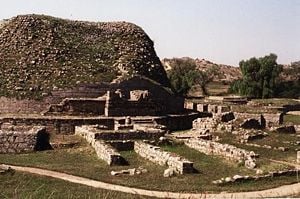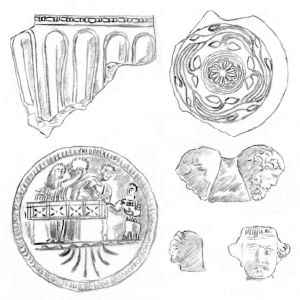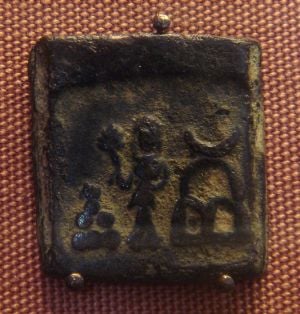Taxila

Taxila is an important archaeological site in Pakistan containing the ruins of the Gandhāran city of Takshashila (also Takkasila or Taxila) an important Vedic/Hindu[1] and Buddhist[2] centre of learning from the sixth century B.C.E.[3] to the fifth century C.E.[4] [5] In 1980, Taxila was declared a UNESCO World Heritage Site with multiple locations.[6]
Historically, Taxila lay at the crossroads of three major trade routes: the royal highway from Pāṭaliputra; the north-western route through Bactria, Kāpiśa, and Puṣkalāvatī (Peshawar); and the route from Kashmir and Central Asia, via Śrinigar, Mānsehrā, and the Haripur valley[7] across the Khunjerab Pass to the Silk Road.
Today, Taxila is situated at the western region of the Islamabad Capital Territory—to the northwest of Rawalpindi and on the border of the Punjab and North West Frontier Provinces—about 30 kilometers west-northwest of Islamabad, just off the Grand Trunk Road.
History

Legend has it that Taksha, an ancient Indian king who ruled in a kingdom called Taksha Khanda (Tashkent) founded the city of Takshashila. The word Takshashila, in Sanskrit means "belonging to the King Taksha." Taksha was the son of Bharata and Mandavi, historical characters who appear in the Indian epic Ramayana.
In the Indian epic Mahābhārata, the Kuru heir Parikṣit was enthroned at Taxila.[8]
Ahmad Hasan Dani and Saifur Rahman Dar trace the etymology of Taxila to a tribe called the Takka.[9] According to Damodar Dharmanand Kosambi, "Taxila" is related to "Takṣaka," which means "carpenter" and is an alternative name for the Nāga.[10]
- c. 518 B.C.E. – Darius the Great annexes the North-West of the Indian-Subcontinent (modern day Pakistan), including Taxila, to the Persian Achaemenid Empire.[11]
- c. 450 B.C.E., Herodotus makes reference to Greek influences in this area. The language used in the area is bilingual for the better part of 1000 years, with Greek being the second language. See coins that reflect this bilingual function.
- 326 B.C.E. – Alexander the Great receives submission of Āmbhi,[12] king of Taxila, and afterwards defeats Porus at the Jhelum River.[13]
- c. 317 B.C.E. – In quick succession, Alexander's general Eudemus and then the satrap Peithon withdraw from India.[14] Candragupta, founder of the Mauryan Empire, then makes himself master of the Punjab. Chandragupta Maurya's advisor Kautilya (also known as Chanakya) was a teacher at Taxila.
- During the reign of Chandragupta's grandson Aśoka, Taxila became a great Buddhist centre of learning. Nonetheless, Taxila was briefly the center of a minor local rebellion, subdued only a few years after its onset.[15]
- 185 B.C.E. – The last Maurya emperor, Bṛhadratha, is assassinated by his general, Puṣyamitra Śunga, during a parade of his troops.[16]
- 183 B.C.E. – Demetrios conquers Gandhāra, the Punjab and the Indus valley.[17] He builds his new capital, Sirkap, on the opposite bank of the river from Taxila.[18] During this new period of Bactrian Greek rule, several dynasties (like Antialcidas) likely ruled from the city as their capital. During lulls in Greek rule, the city managed profitably on its own, managed independently and controlled by several local trade guilds, who also minted most of the city's autonomous coinage.
- c. 90 B.C.E. – The Indo-Scythian chief Maues overthrows the last Greek king of Taxila.[19]
- c. 25 C.E. – Gondophares, founder of the Indo-Parthian Kingdom, conquers Taxila and makes it his capital.[20].
- 76 – The date of an inscription found at Taxila of 'Great King, King of Kings, Son of God, the Kushana' (maharaja rajatiraja devaputra Kushana).[21]
- c. 460–470 – The Ephthalites (known as the White Huns) sweep over Gandhāra and the Punjab; wholesale destruction of Buddhist monasteries and stūpas at Taxila, which never again recovers.[22]
Before the fall of these invader-kings, Taxila had been variously a capital for many dynasties, and a centre of Vedic culture and Buddhist learning, with a population of Buddhists, Classical Hindus, and possibly Greeks who may have endured for centuries.[23]
The British archaeologist Sir John Marshall conducted excavations over a period of 20 years in Taxila.[24]
Ancient centre of learning
Takshashila was an early center of learning dating back to at least the fifth century B.C.E.[25] There is some disagreement about whether Takshashila can be considered a university. While some consider Taxila to be an early university [26] [5] [27] [28] or centre of higher education, [29] others do not consider it a university in the modern sense, [30] [31] [32] in contrast to the later Nalanda University.[32][4][33] Takshashila is described in some detail in later Jātaka tales, written in Sri Lanka around the fifth century C.E.[34]
Takshashila is considered a place of religious and historical sanctity by Hindus and Buddhists. The former do so not only because, in its time, Takshashila was the seat of Vedic learning, but also because the strategist, Chanakya, who later helped consolidate the empire of Emperor Chandragupta Maurya, was a senior teacher there. The institution is very significant in Buddhist tradition since it is believed that the Mahāyāna sect of Buddhism took shape there.
Some scholars date Takshashila's existence back to the sixth century B.C.E.[3] or seventh century B.C.E.[35] It became a noted centre of learning at least several centuries before Christ, and continued to attract students from around the old world until the destruction of the city in the fifth century C.E. Takshashila is perhaps best known because of its association with Chanakya. The famous treatise Arthashastra (Sanskrit for The knowledge of Economics) by Chanakya, is said to have been composed in Takshashila itself. Chanakya (or Kautilya),[36] the Maurya Emperor Chandragupta[37] and the Ayurvedic healer Charaka studied at Taxila.[38]
Generally, a student entered Takshashila at the age of 16. The Vedas and the Eighteen Arts, which included skills such as archery, hunting, and elephant lore, were taught, in addition to its law school, medical school, and school of military science.[38]
Taxila Today

* Fluted cup (Bhir Mound, stratum 1) * Cup with rosace and decorative scroll (Bhir Mound, stratum 1) * Stone palette with individual on a couch being crowned by standing woman, and served (Sirkap, stratum 5) * Handle with double depiction of a philosopher (Sirkap, stratum 5) * Woman with smile (Sirkap, stratum 5) * Man with moustache (Sirkap, stratum 5)
Present day Taxila is one of the seven Tehsils (sub-district) of Rawalpindi District. It is spread over an undulating land in the periphery of the Pothohar Plateau of the Punjab. Situated just outside the capital Islamabad's territory and communicating with it through Tarnol Pass of Margalla Hills, Taxila is a mix of posh urban and rustic rural environs. Urban residential areas are in the form of small neat and clean colonies populated by the workers of heavy industries, educational institutes and hospitals that are located in the area.
The industries include heavy machine factories and industrial complex, ordnance factories of Wah Cantt and cement factory. Heavy Industries Taxila is also based here. Small, cottage and house hold industries include stone ware, pottery and footwear. People try to relate the present day stone ware craft to the tradition of sculpture making that existed here before the advent of Islam.
In addition to the ruins of Gandhara civilization and ancient Buddhist/Hindu culture, relics of Mughal gardens and vestiges of historical Grand Trunk Road, which was built by Emperor Sher Shah Suri in fifteenth-sixteenth centuries, are also found in Taxila region.
Taxila Museum, dedicated mainly to the remains of Gandhara civilization, is also worth visiting. A hotel of the tourism department offers reasonably good services and hospitality to the tourists.
Taxila has many educational institutes including University of Engineering and Technology (UET). Thomas is still honored in Taxila in an annual festival in early July, attended by thousands, celebrating the passage of his bones through Taxila on their way to Edessa.
Some notable and famous people of Taxila are Khan Mohammad Younas Khan, Ghulam Sarwar Khan (minister for labour and Overseas Pakistanis) and Siddique Khan (town nazim).
Notes
- ↑ Raychauduri Majumdar, H.C. Raychaudhuri, and Kaukinkar Datta. An Advanced History of India. (London: Macmillan, 1946), 64
- ↑ UNESCO World Heritage List. 1980. Taxila: Brief Description. Retrieved 13 January 2007
- ↑ 3.0 3.1 "History of Education," Encyclopædia Britannica, 2007.
- ↑ 4.0 4.1 "Nalanda" (2007). Encarta.
- ↑ 5.0 5.1 Joseph Needham. Within the Four Seas: The Dialogue of East and West. (Routledge, 2004. ISBN 0415361664):
"When the men of Alexander the great came to Taxila in India in the fourth century B.C.E. they found a university there the like of which had not been seen in Greece, a university which taught the three Vedas and the eighteen accomplishments and was still existing when the Chinese pilgrim Fa-Hsien went there about AD 400."
- ↑ UNESCO World Heritage Site. 1980. Taxila: Multiple Locations. Retrieved 13 January 2007.
- ↑ Romila Thapar. Aśoka and the Decline of the Mauryas. (1961) (Oxford, UK: Oxford University Press, 1997. ISBN 0195639324), 237
- ↑ Damodar Dharmanand Kosambi. An Introduction to the study of Indian History, Revised Second Ed. (1956) (Bombay: Popular Prakashan, 1975), 126
- ↑ Hartmut Scharfe. Education in Ancient India. (Brill Academic Publishers, 2002. ISBN 9004125566).
- ↑ Kosambi, 1975, 129
- ↑ John Marshall, (archaeologist). Taxila: Volume I. (1951) (Delhi: Motilal Banarsidass, 1975), 83
- ↑ Named "Taxiles" by Greek sources after his capital city.
- ↑ Marshall, 1975, 83
- ↑ Peithon was named by Alexander satrap of Sindh, and was again confirmed to the Gandhara region by the Treaty of Triparadisus in 320 B.C.E.: "The country of the Parapamisians was bestowed upon Oxyartes, the father of Roxane; and the skirts of India adjacent to Mount Parapamisus, on Peithon the son of Agenor. As to the countries beyond that, those on the river Indus, with the city Patala (the capital of that part of India) were assigned to Porus. Those upon the Hydaspes, to Taxiles the Indian." Arrian "Anabasis, the Events after Alexander." He ultimately left in 316 B.C.E., to become satrap of Babylon in 315 B.C.E., before dying at the Battle of Gaza in 312 B.C.E.
- ↑ Thapar 1997
- ↑ Hermann Kulke and Dietmar Rothermund. A History of India, Third Ed. (1986) (London: Routledge, 1998. ISBN 0415154812), 68
- ↑ Marshall, 1975, 83
- ↑ Kulke and Rothermund, 1998, 70
- ↑ Marshall, 1975, 84
- ↑ Marshall, 1975, 85
- ↑ Kulke and Rothermund, 1998, 75
- ↑ Marshall, 1975, 86
- ↑ The Life of Apollonius of Tyana, by Philostratus, Christopher P. Jones (Translator) Vol. 1: Books 1-4 (Loeb Classical Library, No. 16, 2005. ISBN 0674996135) demonstrates that the rulers of Taxila spoke Greek several centuries after Greek political dominance had faded.
- ↑ Sir John Marshall. A Guide to Taxila. (Karachi: Department of Archaeology in Pakistan, Sani Communications, 1960)
- ↑ Scharfe, 2002.
- ↑ Radha Kumud Mookerji. Ancient Indian Education: Brahmanical and Buddhist, 2nd ed. (Delhi: Motilal Banarsidass Publ., (1951) reprint 1989, ISBN 8120804236), 478
"Thus the various centres of learning in different parts of the country became affiliated, as it were, to the educational centre, or the central university, of Taxila which exercised a kind of intellectual suzerainty over the wide world of letters in India."
- ↑ Hermann Kulke and Dietmar Rothermund (2004), A History of India, Routledge, ISBN 0415329191:
"In the early centuries the centre of Buddhist scholarship was the University of Taxila".
- ↑ Balakrishnan Muniapan, Junaid M. Shaikh (2007), "Lessons in corporate governance from Kautilya's Arthashastra in ancient India," World Review of Entrepreneurship, Management and Sustainable Development 3(1):
"Kautilya was also a Professor of Politics and Economics at Taxila University. Taxila University is one of the oldest known universities in the world and it was the chief learning centre in ancient India."
- ↑ Radha Kumud Mookerji. Ancient Indian Education: Brahmanical and Buddhist, 2nd ed. (Delhi: Motilal Banarsidass Publ., (1951) reprint 1989, ISBN 8120804236), 479
"This shows that Taxila was a seat not of elementary, but higher, education, of colleges or a university as distinguished from schools."
- ↑ Anant Sadashiv Altekar. Education in Ancient India, Sixth Ed., Revised & Enlarged, (Varanasi: Nand Kishore & Bros, (1934) reprint 1965),
"It may be observed at the outset that Taxila did not possess any colleges or university in the modern sense of the term."
- ↑ F. W. Thomas (1944), in John Marshall Taxila. (Delhi: Motilal Banarsidass, (1951) 1975 reprint)
"We come across several Jātaka stories about the students and teachers of Takshaśilā, but not a single episode even remotely suggests that the different 'world renowned' teachers living in that city belonged to a particular college or university of the modern type."
- ↑ 32.0 32.1 Taxila (2007), Encyclopædia Britannica:
"Taxila, besides being a provincial seat, was also a centre of learning. It was not a university town with lecture halls and residential quarters, such as have been found at Nalanda in the Indian state of Bihar."
- ↑ "Nalanda" (2001). Columbia Encyclopedia.
- ↑ Marshall, 1975, 81
- ↑ "Taxila," Columbia Encyclopedia, 2001.
- ↑ Kautilya. Encyclopaedia Britannica.
- ↑ Radhakumud Mookerji. Chandragupta Maurya and His Times. (Delhi: Motilal Banarsidass Publ., (1941) 1960; reprint 1989. ISBN 8120804058), 17.
- ↑ 38.0 38.1 Radha Kumud Mookerji. Ancient Indian Education: Brahmanical and Buddhist, 2nd ed. (Delhi: Motilal Banarsidass Publ., (1951) reprint 1989. ISBN 8120804236), 478-489.
ReferencesISBN links support NWE through referral fees
- Altekar, Anant Sadashiv. Education in Ancient India. Varanasi: Nand Kishore & Brothers, 1965.
- Chakrabarti, D.K. Buddhist sites across South Asia as influenced by political and economic forces. World Archaeology 27(2)(1995): 185-202.
- Khettry, Sarita. Buddhism in North-Western India: Up to C. A.D. 650. Kolkata: R.N. Bhattacharya, 2006. ISBN 9788187661573.
- Kosambi, Damodar Dharmanand. An Introduction to the study of Indian History, Revised Second Ed. (1956) Bombay: Popular Prakashan, 1975.
- Kulke, Hermann, and Dietmar Rothermund. A History of India, Third Ed. (1986) (London: Routledge, 1998. ISBN 0415154812
- Majumdar, Raychauduri, H.C. Raychaudhuri, and Kaukinkar Datta. An Advanced History of India. London: Macmillan, 1946.
- Marshall, John. A Guide to Taxila. Karachi: Department of Archaeology in Pakistan, Sani Communications, 1960.
- Marshall, John. Taxila: Volume I. (1951) Delhi: Motilal Banarsidass, 1975.
- Mitra, D. Buddhist Monuments. Calcutta: Sahitya Samsad, 1971. ISBN 0896844900.
- Mookerji, Radha Kumud. Ancient Indian Education: Brahmanical and Buddhist, 2nd ed. Delhi: Motilal Banarsidass Publ., (1951) reprint 1989, ISBN 8120804236.
- Mookerji, Radhakumud. Chandragupta Maurya and His Times. Delhi: Motilal Banarsidass Publ., (1941) 1960; reprint 1989. ISBN 8120804058.
- Needhamm Joseph. Within the Four Seas: The Dialogue of East and West. Routledge, 2004. ISBN 0415361664.
- Scharfe, Harmut. Education in Ancient India. Brill Academic Publishers, 2002. ISBN 9004125566.
- Tadgell, C. The History of Architecture in India. London: Phaidon, 1990. ISBN 1854543504.
- Thapar, Romila. Aśoka and the Decline of the Mauryas. (1961) Oxford, UK: Oxford University Press, 1997. ISBN 0195639324.
- Thomas, F.W. (1944), in John Marshall. Taxila. Delhi: Motilal Banarsidass, (1951) reprint 1975.
Credits
New World Encyclopedia writers and editors rewrote and completed the Wikipedia article in accordance with New World Encyclopedia standards. This article abides by terms of the Creative Commons CC-by-sa 3.0 License (CC-by-sa), which may be used and disseminated with proper attribution. Credit is due under the terms of this license that can reference both the New World Encyclopedia contributors and the selfless volunteer contributors of the Wikimedia Foundation. To cite this article click here for a list of acceptable citing formats.The history of earlier contributions by wikipedians is accessible to researchers here:
The history of this article since it was imported to New World Encyclopedia:
Note: Some restrictions may apply to use of individual images which are separately licensed.



